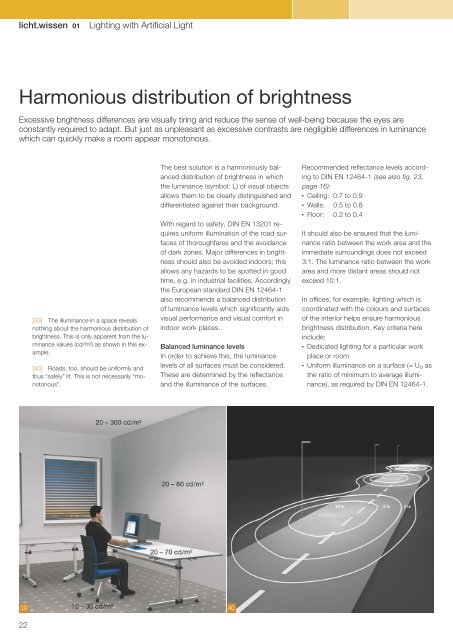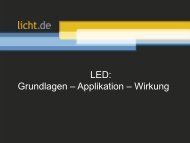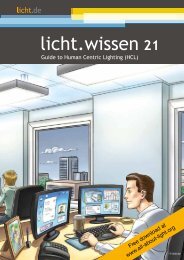licht.wissen No. 01 "Lighting with Artificial Light"
Booklet 1 is intended for all those who want to delve into the topic of light and lighting or wish to familiarize themselves with the basics of lighting technology. It also helps to make a decision in the field of lighting. Free Download at www.licht.de/en
Booklet 1 is intended for all those who want to delve into the topic of light and lighting or wish to familiarize themselves with the basics of lighting technology. It also helps to make a decision in the field of lighting. Free Download at www.licht.de/en
Create successful ePaper yourself
Turn your PDF publications into a flip-book with our unique Google optimized e-Paper software.
<strong>licht</strong>.<strong>wissen</strong> <strong>01</strong><br />
<strong>Lighting</strong> <strong>with</strong> <strong>Artificial</strong> Light<br />
Harmonious distribution of brightness<br />
Excessive brightness differences are visually tiring and reduce the sense of well-being because the eyes are<br />
constantly required to adapt. But just as unpleasant as excessive contrasts are negligible differences in luminance<br />
which can quickly make a room appear monotonous.<br />
[39] The illuminance in a space reveals<br />
nothing about the harmonious distribution of<br />
brightness. This is only apparent from the luminance<br />
values (cd/m 2 ) as shown in this example.<br />
[40] Roads, too, should be uniformly and<br />
thus “safely” lit. This is not necessarily “monotonous”.<br />
The best solution is a harmoniously balanced<br />
distribution of brightness in which<br />
the luminance (symbol: L) of visual objects<br />
allows them to be clearly distinguished and<br />
differentiated against their background.<br />
With regard to safety, DIN EN 132<strong>01</strong> requires<br />
uniform illumination of the road surfaces<br />
of thoroughfares and the avoidance<br />
of dark zones. Major differences in brightness<br />
should also be avoided indoors; this<br />
allows any hazards to be spotted in good<br />
time, e.g. in industrial facilities. Accordingly<br />
the European standard DIN EN 12464-1<br />
also recommends a balanced distribution<br />
of luminance levels which significantly aids<br />
visual performance and visual comfort in<br />
indoor work places.<br />
Balanced luminance levels<br />
In order to achieve this, the luminance<br />
levels of all surfaces must be considered.<br />
These are determined by the reflectance<br />
and the illuminance of the surfaces.<br />
Recommended reflectance levels according<br />
to DIN EN 12464-1 (see also fig. 23,<br />
page 16):<br />
<br />
Ceiling: 0.7 to 0.9<br />
<br />
Walls: 0.5 to 0.8<br />
<br />
Floor: 0.2 to 0.4<br />
It should also be ensured that the luminance<br />
ratio between the work area and the<br />
immediate surroundings does not exceed<br />
3:1. The luminance ratio between the work<br />
area and more distant areas should not<br />
exceed 10:1.<br />
In offices, for example, lighting which is<br />
coordinated <strong>with</strong> the colours and surfaces<br />
of the interior helps ensure harmonious<br />
brightness distribution. Key criteria here<br />
include:<br />
<br />
Dedicated lighting for a particular work<br />
place or room<br />
<br />
Uniform illuminance on a surface (= U O as<br />
the ratio of minimum to average illuminance),<br />
as required by DIN EN 12464-1.<br />
39<br />
40<br />
22

















